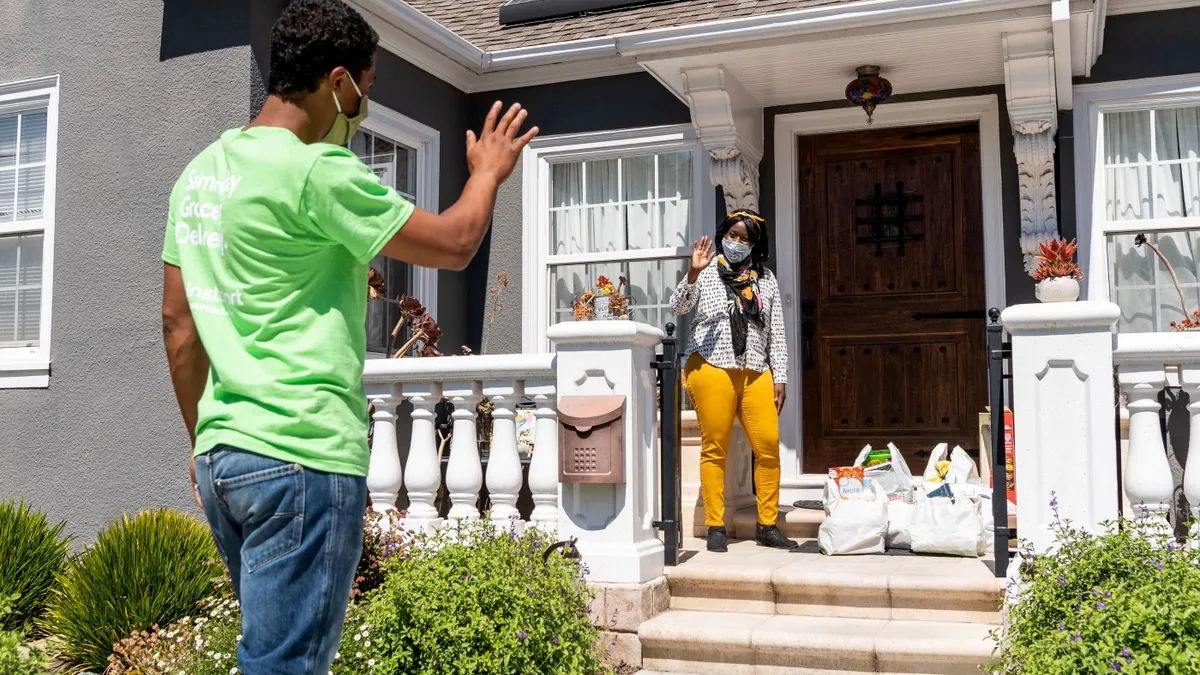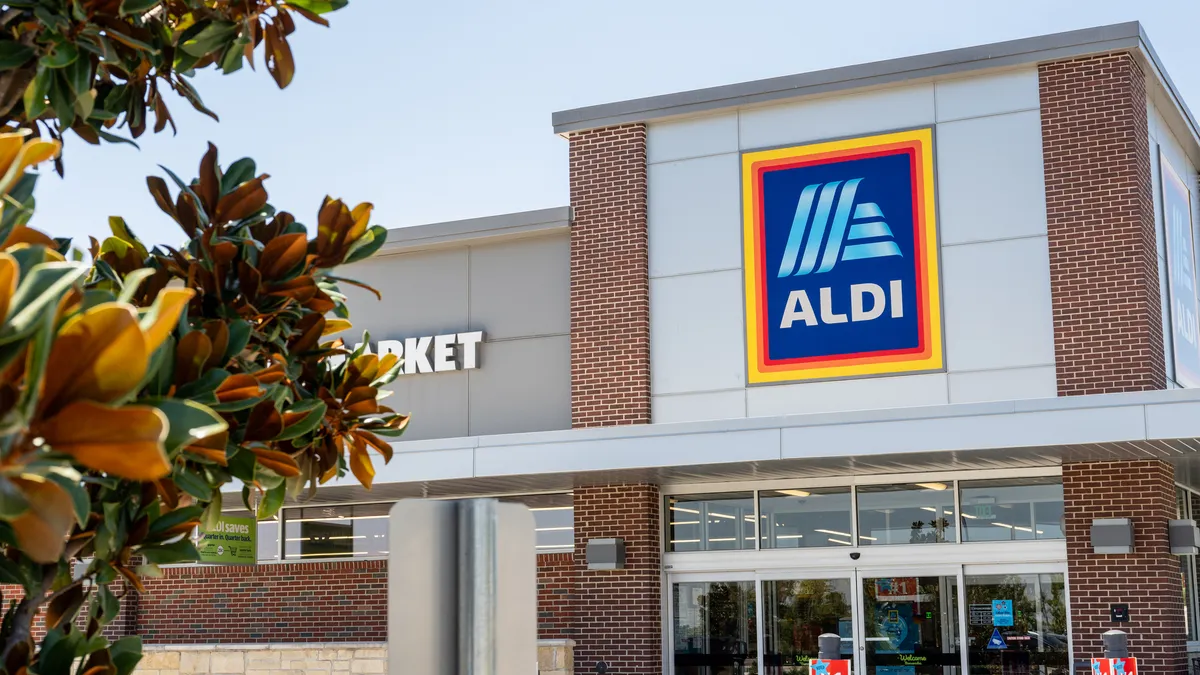Pardon the Disruption is a column that looks at the forces shaping food retail.
Will Instacart become a grocer?
It's a question people in the grocery industry have been asking for years. And it's one that's worth revisiting because the company that's made its fortune filling orders from stores is now exploring separate fulfillment facilities.
The Financial Times recently reported Instacart has sent requests for proposals and engaged in talks with automated fulfillment firms like Alert Innovation and Fabric over the past year, with initial plans to build as many as 50 robot-powered facilities across the country to offer fulfillment as a service for its partner retailers. The company is working with ex-Walmart fulfillment executive Mark Ibbotson and has hired a director of next-gen fulfillment who previously worked for Lyft — news first reported by Winsight Grocery Business, and confirmed by two sources I spoke with recently.
This all makes perfect sense for Instacart. The boom in online ordering during the pandemic has made the inefficiencies of its store fulfillment model all the more glaring. The tech company, which is now valued at $39 billion and speeding toward a public offering as it stocks its shelves with pricey new executive talent, needs to improve its fulfillment operations or risk falling behind.
But there are plenty of reasons to believe retailers won't be nearly as eager to follow Instacart down this path as they were when they signed up for its services following Amazon's acquisition of Whole Foods. The pandemic has pushed e-commerce adoption ahead of schedule, and that's motivating retailers to take more control of their front- and back-end operations. Sprouts Farmers Market, for one, said in its latest earnings report that 15% of its online sales are now coming through its own platform, and it has substituted its own employees in place of Instacart gig workers to pick and pack orders. The Financial Times, meanwhile, reported Instacart has so far struggled to generate interest from grocers in contracting offsite fulfillment services, citing a reluctance to turn over more of their business operations to the company.
At a time when Instacart needs to be deepening its relationships with retailers, those retailers are instead pushing back. They no longer want Instacart monopolizing their customers' data and online experience. And they want their own workers, who know their stores best and can be held more accountable for things like accuracy and customer service, doing more of the fulfilling.
At the same time, Instacart faces mounting pressure from investors and consumers to offer a wide assortment of groceries delivered as quickly and cheaply as possible. Research has shown that many consumers, in fact, already think Instacart is a grocer.
So why not make it official? Faced with these conflicting pressures — retailers pulling back, market forces pushing it forward — Instacart could fill up those dark facilities with its own product and become an online grocer. InstaMart has a nice ring to it.
"At the end of the day, I think there is going to be so much pressure for them to go direct, to try to do something big to maintain their valuation," said Gary Hawkins, CEO of the Center for Advancing Retail & Technology. "I don't think they're going to have a choice."
Instacart, of course, has long maintained that partnering with grocers and not competing with them is sacrosanct. In a statement, the company said: "We're constantly evaluating our services in deep partnership with the nearly 600 retailers we work with. Instacart's entire product and model is predicated on being a chief ally to our retail partners. We're not a retailer and our business is only successful when we're driving value for our partners."
There's no reason why Instacart wouldn't go back on its word, however, if it made overwhelming sense to do so. The e-commerce landscape is evolving rapidly as Amazon and Walmart move upstream. Hawkins, along with numerous industry experts that have debated the matter on LinkedIn over the past few weeks, points out that Instacart, with its bevy of consumer data and relationships with CPG companies through its digital media business, would be able to move seamlessly into direct sales — and may have been planning such a move all along, despite its insistence to the contrary.
"They know exactly what is selling in every market that they're in," Hawkins said.
DoorDash, a competing third-party delivery company, has already gone direct with its DashMart service, scaling its dark convenience stores to several cities even as it links up with retailers to provide home delivery.
Instacart could offer its own marketplace of products, possibly convenience-focused. The move would no doubt make grocers irate, but it's not so easy for them to unwind from Instacart's marketplace, which turns a fire hose of customer demand onto retailers. According to a recent report from 1010Data, Instacart now accounts for 28% of online grocery market share — the highest in the industry — and grew sales 323% last year.
"At the end of the day, I think there is going to be so much pressure for them to go direct, to try to do something big to maintain their valuation. I don't think they're going to have a choice."

Gary Hawkins
CEO, Center for Advancing Retail & Technology
The case against InstaMart
On the other hand, why would a hotshot technology firm want to wade into grocery? It's a tough business, even with troves of consumer data on hand. It's expensive, highly competitive and requires a great deal of merchandising and supply chain sophistication Instacart doesn’t currently possess.
There's also reason to believe Instacart's partnership approach to fulfillment could succeed with the many small and mid-sized grocers that need to improve their fulfillment operations, but don’t have the capital to invest in dark stores and automated centers on their own. I spoke with one retailer source who doesn't believe it makes sense for Instacart to sell direct to consumers, given the difficulties of grocery and the upside of its service model. He said his company is investing in capturing data and owning the customer experience, and is less interested in investing in fulfillment operations. Grocers without the capital budget of a Walmart, Kroger or Albertsons, he said, have to pick what parts of e-commerce they want to own and what they want to outsource.
"Do we need to own fulfillment and last-mile delivery? I don’t think so," said the source, who asked not to be identified.
Another person I spoke with who has direct knowledge of Instacart’s exploration process agreed becoming an online grocer isn't a good fit for Instacart, and said fulfillment as a service could offer benefits for grocers compared to the current Instacart model. Fulfilling orders out of dedicated facilities could reduce fees for retailers by reducing picking costs, making it a more attractive option in markets where order volumes are high. It would also make ordering more precise and less prone to all the product substitutions shoppers have to suffer through, the source said.
Still, there are plenty of operational questions to be answered, which Instacart still seems to be figuring out, the source said. "Are they going to be picking just Instacart orders or are they going to pick the other orders for the retailer? And who owns the building?" Instacart may also want to open non-automated dark stores, which can optimize fulfillment without all the costly robotics.
One difficulty in appealing to small and mid-sized retailers is they may not generate enough online business to justify a dedicated facility. Instacart could fulfill orders for more than one grocer out of a facility, though there would likely be competitive concerns in that venture.
However, grocers probably wouldn't mind sharing fulfillment space with many of the nonfood retailers Instacart continues to sign up, including Best Buy, Sephora and even Walgreens. The opportunity to offer fulfillment as a service to non-grocery companies, which don’t see nearly as much order frequency at the local level as grocery stores do, strengthens the case for Instacart not going direct to shoppers.
Instacart vacuums up customer data and competes with retailers for trade dollars. That's made the relationship between it and its grocery clients a tricky one as the firm also tries to sell grocers on its white-label website services, fulfillment technology and more. That relationship would completely sour if Instacart began competing directly with grocers, and likely spur them to cut every tie with the company outside of the Instacart Marketplace, which funnels so many shoppers to grocery brands.
It's also not hard to imagine Instacart getting into other retailer services like checkout technology or in-store robotics before leaping into online grocery, with its low margins and loads of assets.
Instacart may have every intention of continuing its strategy of partnering with retailers. It's a strategy that has quieted naysayers and powered it through Amazon's acquisition of Whole Foods and the pandemic to a record valuation and eye-popping e-commerce market share. Straying into uncharted territory may seem like a terribly risky and unnecessary move at this point.
Still, the book on grocery e-commerce is still in its early chapters. With so much at stake and so much still to be written, from acquisitions to unforeseen events like the pandemic, it's difficult to rule out InstaMart one day popping up on shoppers' phones and computer screens.

















